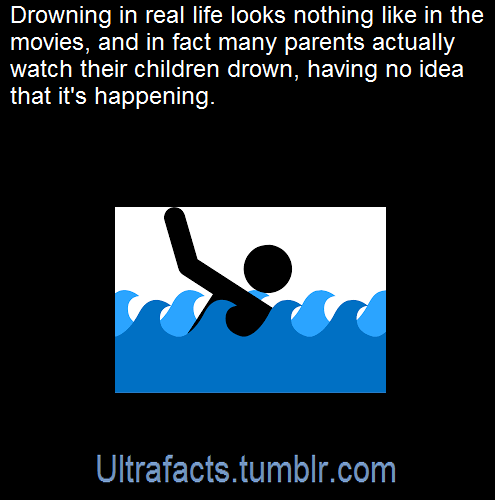inspector-loki: faikitty: mermaibee: ultrafacts: According to the CDC, in 10 percent of those drowni
inspector-loki: faikitty: mermaibee: ultrafacts: According to the CDC, in 10 percent of those drownings, the adult will actually watch the child do it, having no idea it is happening. Drowning does not look like drowning—Dr. Pia, in an article in the Coast Guard’s On Scene magazine, described the Instinctive Drowning Response like this: “Except in rare circumstances, drowning people are physiologically unable to call out for help. The respiratory system was designed for breathing. Speech is the secondary or overlaid function. Breathing must be fulfilled before speech occurs. Drowning people’s mouths alternately sink below and reappear above the surface of the water. The mouths of drowning people are not above the surface of the water long enough for them to exhale, inhale, and call out for help. When the drowning people’s mouths are above the surface, they exhale and inhale quickly as their mouths start to sink below the surface of the water. Drowning people cannot wave for help. Nature instinctively forces them to extend their arms laterally and press down on the water’s surface. Pressing down on the surface of the water permits drowning people to leverage their bodies so they can lift their mouths out of the water to breathe. Throughout the Instinctive Drowning Response, drowning people cannot voluntarily control their arm movements. Physiologically, drowning people who are struggling on the surface of the water cannot stop drowning and perform voluntary movements such as waving for help, moving toward a rescuer, or reaching out for a piece of rescue equipment. From beginning to end of the Instinctive Drowning Response people’s bodies remain upright in the water, with no evidence of a supporting kick. Unless rescued by a trained lifeguard, these drowning people can only struggle on the surface of the water from 20 to 60 seconds before submersion occurs.” This doesn’t mean that a person that is yelling for help and thrashing isn’t in real trouble—they are experiencing aquatic distress. Not always present before the Instinctive Drowning Response, aquatic distress doesn’t last long—but unlike true drowning, these victims can still assist in their own rescue. They can grab lifelines, throw rings, etc. Look for these other signs of drowning when persons are in the water: Head low in the water, mouth at water level Head tilted back with mouth open Eyes glassy and empty, unable to focus Eyes closed Hair over forehead or eyes Not using legs—vertical Hyperventilating or gasping Trying to swim in a particular direction but not making headway Trying to roll over on the back Appear to be climbing an invisible ladder So if a crew member falls overboard and everything looks OK—don’t be too sure. Sometimes the most common indication that someone is drowning is that they don’t look like they’re drowning. They may just look like they are treading water and looking up at the deck. One way to be sure? Ask them, “Are you all right?” If they can answer at all—they probably are. If they return a blank stare, you may have less than 30 seconds to get to them. And parents—children playing in the water make noise. When they get quiet, you get to them and find out why. Source/article: [x] Follow Ultrafacts for more facts! BOOST FOR THE SUMMER. PLEASE PLEASE PLEASE. Can I just say thank you to OP for putting such a detailed description on this? I’ve been a lifeguard for 6 years now and of all the saves I’ve done, maybe two or three had people drowning in the stereotypical thrashing style. And even those, like the save I made last weekend, it was exactly like OP describes where the person’s head is going in and out of the water but it isn’t long enough to get any air. Mostly you recognize drowning by the look on someone’s face. If someone looks wide eyed and terrified or confused, chances are they’re drowning. That look of “oh shit” is pretty easily recognizable. And even if you can’t tell for sure: GO AFTER THEM ANYWAY. I’ve done “saves” where a kid was pretending to drown and I mistook it for real drowning, but that’s preferable to a kid ACTUALLY drowning. Also please remember that even strong swimmers can drown if they have a medical emergency, get cramps, or get too tired. If your friend knows how to swim but they’re acting funny get them to land. And even if someone can respond when you ask them if they need help, if they say they do need help? GO HELP THEM. However . If the victim is a stranger, I can’t recommend trying to get them. Lifeguards literally train to escape “attacks,” because people who are drowning can freak the fuck out and grab you and make YOU drown as well. If you do go in after someone, take hold of them from the back and talk to them the whole time. IF YOU ARE GRABBED: duck down into the water as low as you can get. The person is panicking and won’t want to go under water and should release you. Shove up at their hands and push them away from you as you duck under. Don’t die trying to save someone else. Please guys, read and memorize this post. Not all places have lifeguards. Being able to recognize drowning is such an important skill to have and you can save someone’s life. Just incase! -- source link
